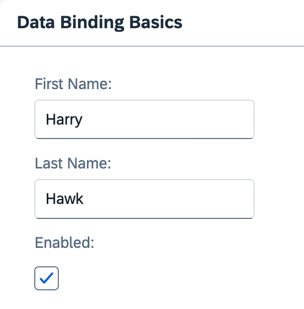Step 6: Resource Models
The example we used at the start of this tutorial was quite simplistic as we stored language-specific text directly in a JSON model object. Generally speaking, unless language-specific text comes directly from a back-end system, it's not considered good programming practice to put translatable texts directly into a model. So, let's fix this by placing all translatable texts (such as field labels) into a resource bundle.
Preview

Coding
You can view and download all files in the Demo Kit at Data Binding - Step 6.
-
Create a new entry in the
manifest.jsonfile under themodelsentry as shown in the coding below. The resource model is set to the component using the model namei18n. The data comes from thei18n.propertiesfile as specified in thebundleNameentry in the settings. Since we're creating a resource model, the file name is assumed to have the extension.properties; this does not need to be stated explicitly.webapp/manifest.json
... "sap.ui5": { "dependencies": { "minUI5Version": "1.120.0", "libs": { "sap.m": {}, "sap.ui.core": {}, "sap.ui.layout": {} } }, "models": { "": { "type": "sap.ui.model.json.JSONModel", "uri": "./model/data.json" }, "i18n": { "type": "sap.ui.model.resource.ResourceModel", "settings": { "bundleName": "ui5.databinding.i18n.i18n", "supportedLocales": [ "", "de" ], "fallbackLocale": "" } } }, ...The configured
supportedLocalesrepresent the following i18n files present (see Step 7):""-i18n/i18n.properties-
"de"-i18n/i18n_de.properties
The configured
fallbackLocaleshould represent one of these files. According to the fallback chain, the root bundle ("") is the last fallback. Configuring it explicitly avoids side effects when additional resource files are added. For more information, see Supported Locales and Fallback Chain. -
Create a new folder
i18nin thewebappfolder and a new filei18n.propertieswithin this folder. Add the code shown below.webapp/i18n/i18n.properties (New)
# Field labels firstName=First Name lastName=Last Name enabled=Enabled # Screen titles panelHeaderText=Data Binding BasicsThe
panelHeaderTextproperty has been moved from the JSON model into thei18nresource bundle. Also, the field labels are no longer hard-coded in the XML view. This is because all of these text fields need to be translated.Language-specific text stored in resource models obeys the Java convention for internationalization (i18n).
-
Modify the data binding for the panel header and the labels in
App.view.xmlto include the model name. Note that a "greater than" character separates the model name and the property name. Also, i18n property names must not start with a slash character.webapp/view/App.view.xml
<mvc:View xmlns="sap.m" xmlns:form="sap.ui.layout.form" xmlns:mvc="sap.ui.core.mvc"> <Panel headerText="{i18n>panelHeaderText}" class="sapUiResponsiveMargin" width="auto"> <form:SimpleForm editable="true" layout="ColumnLayout"> <Label text="{i18n>firstName}"/> <Input value="{/firstName}" valueLiveUpdate="true" width="200px" enabled="{/enabled}"/> <Label text="{i18n>lastName}"/> <Input value="{/lastName}" valueLiveUpdate="true" width="200px" enabled="{/enabled}"/> <Label text="{i18n>enabled}"/> <CheckBox selected="{/enabled}"/> </form:SimpleForm> </Panel> </mvc:View> -
Remove the line
panelHeaderText : "Data Binding Basics"from the model data in thedata.jsonfile. This text has now been moved to the resource model.webapp/model/data.json
{ "firstName": "Harry", "lastName": "Hawk", "enabled": true } -
Remove the
initfunction and the import ofsap/ui/model/BindingModefromComponent.jsas we do not want to set the one-way binding mode anymore.webapp/Component.js
sap.ui.define([ "sap/ui/core/UIComponent" ], (UIComponent) => { "use strict"; return UIComponent.extend("ui5.databinding.Component", { metadata: { interfaces: ["sap.ui.core.IAsyncContentCreation"], manifest: "json" } }); });
You can use multiple model instances by using different model names. The model name can be set as the second parameter when using the
setModel(oResourceModel,"i18n") method. The model is then propagated under this name to all aggregated child
controls (and their children, and so on …). All these controls have access to this model under the name i18n as well
as to the JSONModel (default model, which has no name).
Parent topic: Data Binding Tutorial
Previous: Step 5: One-Way Data Binding